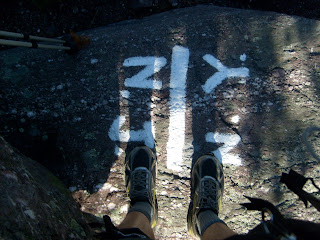Here my feet straddle two states. I have had three sprains on the left and two on the right over the years. And I still hiked the trail in my Brooks Adrenaline ASR trail runners.
Ankles seem to be a big cause for concern out on the trail. Either receiving a sprain on the trail or having "weak" ankles from a previous injury or sport. I have had both. I suffered a severe ankle sprain, both what they call inversion and eversion, of my ankle eight years ago. I was told I'd never hike again.
But I did hike again, after finding the right sports doctor with the goal to get me up and hiking. That is the key. If you have suffered an injury and are a hiker, you want to get up and going as soon as you can, safely, without reinjury. So proper rehabilitation of the ankle is so important. Once you've had the injury and then afterwards. Many have said because of weak ankles they have to resort to huge heavy clunky boots to hike even the Appalachian Trail. That just isn't so. Because of careful rehabilitation of my multiple ankle injuries each time, I did the AT north and south in trail runners, including the rocks of PA and the high country of the Whites in NH. And I used poles also for stability. I found a few tricks that enabled me to wear comfortable and good footwear without having to wear 2 lb boots that can lead to other issues, like knee and calf pain in long distances.
With an initial injury or a flair up of tendonitis, ICE is the key. Or as they say, RICE. Rest, Ice, Compression, Elevation. NEVER put heat on any injured ligament or tendon. It doesn't matter how long its been since your injury. Use ICE only. Use a frozen bag of peas. Or freeze a styrofoam cup of water and do an ice massage for about ten minutes several times a day (massage right on the skin, don't use it over a cloth). But NEVER use heat for ANY reason.
After RICE, the main key is REHAB after injury! That doesn't mean you have to go to a Physical Therapy place. If you have sustained a pretty bad sprain, professional therapy is good to at least get some ultrasound on the injury you can't get at home. But exercises can be done at home.
First thing's first. Invest in a wobble board. Esp if you have weak ankles.
Its basically a board with a plastic knob on the bottom that you balance on. The one above is the one I bought, but the link has another cheaper version. It's been a lifesaver for me. It helped strengthen my ankles, but more importantly it helped with my balance. So when my foot was jarred on a rock or wood, I immediately was able to compensate. Without the ankle turning. That and the board strengthening the ligaments around the ankle so it can withstand an ankle roll if it happens. Or it can limit it to a light strain, and you can keep hiking. But I HIGHLY recommend everyone recovering from a sprain or with weak ankles get it. I did not twist my ankle once on my southbound hike of the AT. I came close with some slight strains, but it did not happen. I kept on hiking.
Then there are Exercises. Check out the link for some good ways to strengthen your ankle. Just as you work out to get ready for any sporting event you want to accomplish, like running and walking, for those with ankle issues, you need to exercise your ankles and be diligent about it.
As for shoes, get properly fitted by a professional (that cannot be overstated). Make sure you know your foot type and get the right shoe for it (like if you overpronate, are neutral, etc. A shoe specialist can help you). And use good insoles too. I use the blue Superfeet insoles as I have a flatter arch.
With good shoes, good insoles, strengthening ankles with exercises, controlling your balance, plus hiking poles for balance, you are well on your way by leaps and bounds on your next big trail adventure.
Fulfill Your Hiking Dream! Here to help fellow hikers by offering wisdom, ideas, and lessons learned from a two-time AT North and South, Long Trail, Foothills Trail, Allegheny Trail, Colorado Trail, Florida Trail, BMT, Pinhoti, Arizona, Shenandoah Nat'l Park 500 miler completions. Former AT Ridgerunner for six years. Author and Speaker on Hiking and Backpacking. 12,000 miles plus


2 comments:
I broke my foot last week because of an overturned ankle and was looking for exercises to strengthen my ankles. I couldn't have asked for better information. Thanks!
Foot injuries are crucial for people who are into hiking since they rely on the legs for movement and balance. Getting medically cleared before participating in any strenuous physical exercise is a must, if one incurred a leg injury. Patience in the recovery process is a must to avoid recurring or long term reprecussions.
Anita Rose @ Sports Med Online
Post a Comment